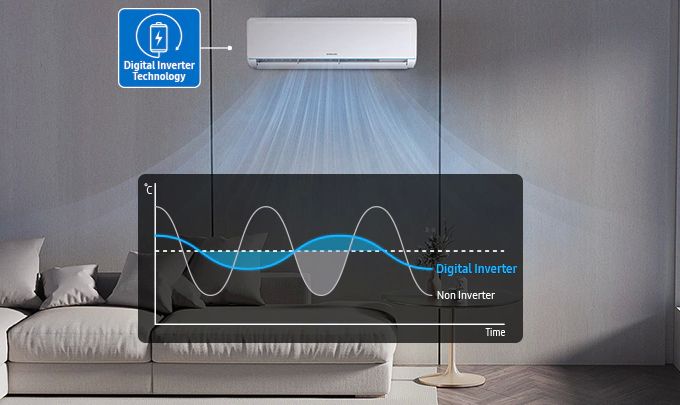Of course, many are familiar with various devices that use inverter motors. Today the market offers inverter refrigerators, inverter washing machines, etc. In fact, this term refers to the method of controlling any motor with the help of adjustable frequency AC. In this case, inversion provides frequency control. Accordingly, such models are called inverter devices.
Operation principle
This term comes from the Latin word inverto, which translates as turn, convert, change. Formally, the inverter air conditioner is the trade name of models that use a change in the AC current frequency for control of engine compressor speed rotation. Initially, this control system converts the AC into a DC, and then the DC converts back to AC current, but with required frequency, providing rotation speed control.
The process of conversion of the DC into AC uses electromagnetic induction at the difference of electric potentials in the conductor under the action of an alternating magnetic field. As known, a coil of wire generates an electrical current near a rotating magnet.
Additionally, this conversion provides adjustment over a wide range. For example, the maximum rotational speed of modern motors reaches 3000 rpm. and higher. Respectively, the performance of the air conditioner also varies widely. Therefore, inverter air conditioners are more economical, provide more flexible and accurate temperature, and can operate over a wider range of outdoor temperatures. Moreover, smooth or multistage adjustment provides a significant increase in operating efficiency depending on the heat load in the room.
These models work as follows. For example, an inverter controller quickly increases the speed of the compressor motor in case of need intensive cooling. Accordingly, the air conditioner starts to work in the forced mode, providing the quick air cooling up to required temperature in the room. Then, it reduces the rotational speed, maintaining a constant temperature with minimal deviations. Of course, the absence of a periodic on / off compressor increases its service life, reduces power consumption and noise level, and also ensures high accuracy of the set temperature, which in modern models reaches ± 1.0 ° C.
Advantages and disadvantages
PROS:
– reduction of compressor wear (average service life reaches 8-12 years as compared with traditional 6-9 years);
– quick setting the set temperature, which reaches ± 10 ° С in 15 minutes versus 30 minutes for traditional models;
– more accurate maintenance of the set temperature due to the smooth control of the compressor engine rotation speed;
– low noise of fans at low speeds (20-26 dB);
– a significant reduction in electricity consumption (30-60% for some models);
– reducing the load on the network due to a decrease in inrush currents.
CONS:
– high price;
– sensitivity to mains voltage surges due to complex electronics;
– increase in energy consumption in continuous operation mode due to losses on the inverter;
– dependence of work on the temperature of outside air (the allowable range is usually from −10 ° С to +42 ° С);
– low level of unification limits the use of spare parts (compressor, start-up relay, temperature sensors, etc.) from other manufacturers.
Of course, companies are constantly improving this technology. For example, in the year 2016, the LG company offered the first air conditioner of the DualCool series. These models use the patented Dual Inverter Compressor.
According to the company, the novelty consumes 70% less electricity. Additionally, it cools the air in the room 40% faster compared to traditional non-inverter models, which is confirmed by the authoritative test center TÜV Rheinland. The video demonstrates this technology.
